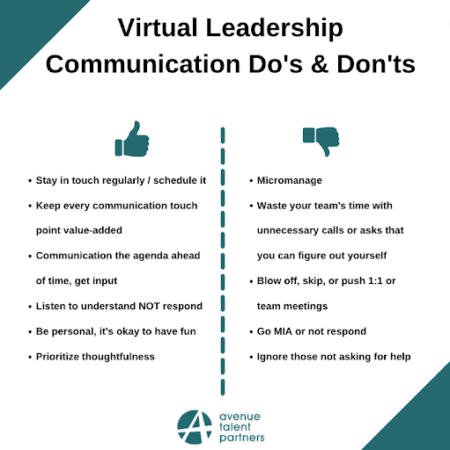
How to Be An Effective Remote Sales Leader
In a world where how we work together has changed, working remotely is front and center, and hybrid teams are quickly becoming “the norm.” How we lead in sales has had to adjust as well.
Our ability to adapt is part of the recipe for leadership success for sales leaders- and anyone else in a leadership role. This changing tide is no different. After all, what got us here, may not get us to the next milestone.
As always, it starts at the top. How we show up as sales leaders directly impact team productivity and how each person feels in their role.
It’s a team sport, companies have to do their part to optimize hiring for remote work opportunities, and leaders need to adapt to the needs of a remote work environment through the hiring, onboarding, and ongoing training/enablement/support process.
It’s important to know these are new skills, and what it takes to be effective in person differs when you’re leading remotely. Give yourself the grace to know you may feel like a fish out of water, it will take time to perfect, and it’s a big shift.
It’s not black or white, either.
Many companies are taking the hybrid approach – i.e., a split between the office, home, or shared office space. There’s a lot of flexibility here to develop a winning strategy that works best for you and your team.
Transitioning to leading a team remotely is no small task, especially if you’ve never done it before.
After 15 years of working remotely, these are my tried and true proven tips when it comes to putting your best remote sales leadership feet forward.
Are YOU a remote leader?
Remote leadership (and remote working in general) isn’t for everyone.
Being a great leader is hard enough! Layer on the challenges of leading a team scattered across the country (or world), and you’re dealing with a different ballgame.
I encourage people to take a hard look in the mirror to reflect on what works best for them, not what others think they should do.
One of the best ways to do that is through the power of journaling. When we write things down, it forces us to be intentional. And it helps us to get clear.
After all, clarity is king, and that’s what we’re going for here.
And if all is said and done and you realize that remote isn’t for you, that’s okay. Regardless of what the interwebs say, there are many opportunities available for leaders to galvanize exceptional teams in-person.
Forcing something that you don’t align with is a recipe for disaster and where businesses and careers are ultimately held back.
Challenges of managing remote teams
Regardless of what anyone says, leading a team remotely IS different.
Many of the same skills are required – like active listening, effective feedback, trust, driving to results, accurate forecasting, inspiring, supporting, training, dependability, etc. – but now it all has to happen in a completely different dynamic.
Here are the big things to look out for in this transition:
Employee burnout
Most people aren’t used to working from home 100% of the time. If your company has recently transitioned to that model, keep in mind that it isn’t going to work for everyone.
Why?
If you’re anything like me, it’s hard to find an “off button.” Boundary setting becomes a superpower.
Loneliness and a true loss of working with others and the camaraderie that comes with it is a very real struggle for many.
Guilty feelings of taking a break for lunch breaks to walk to the next meeting, commuting to unplug… these things are gone and can create a feeling of being dialed into work 24/7.
The 2022 Mental Health in Sales report states 63% of salespeople are struggling with mental health. Understanding how to show up for your people when you’re not with them to see signs they’re struggling every day is a new skill to hone here.
Keeping camaraderie
There’s no community break room in the digital world. And let’s face it: much of the camaraderie between team members comes from in-person meetings or just bumping into someone at the office.
That’s why as a leader, it’s up to you to be proactive to keep the magic alive.
The hardest part about working remotely is the lack of contact with other humans. Finding ways to help your team connect personally while remote is critical!
Creative ways to make your team feel included:
- Eat lunch together, have a walk and talk, or have a virtual coffee break to talk about anything BUT work
- Make notes when you meet with them and follow up; people crave being seen, heard, understood, valued, and validated
- Check on the “quiet ones”
- Create slack channels to celebrate lessons learned and momentous occasions
- Send a random text to say hello just for the heck of it
Keeping people motivated
Working from home means all those enticing comforts and distractions are just a few steps away.

Things you can do:
- Don’t skip 1:1 meetings or push them off
- Take forever to respond to requests/questions
- Waste your team’s time with unnecessary calls that can be solved in Slack/email/etc.
- Create agendas for meetings to make the most out of your time together… and change it up and let your team make the agenda to keep things fresh and engaging
- Communicate expectations early and often… together
- Do a time study to understand where your team is spending their time and help them remove unnecessary roadblocks
- Meet your people where they are, when they need it the most, wherever they are, post-training
Effective communication
With so many apps, platforms, and communication channels at our disposal, you’d think remote communication would be a breeze. But while it might be easy to contact somebody online, this form of communication also comes with a host of other challenges.
For one, body language speaks volumes. Especially digital body language; just because you’re at home doesn’t mean you can show up half-dressed and winging a meeting. You wouldn’t do this in person, it doesn’t fly virtually either.
Visual cues from others help us understand people’s boundaries, tone, and preferences about something.

How you show up matters – a lot.
You can’t fake care. This is one of your strongest assets as a leader. When you lean in, your team will lean back.
Remember, online or offline, we’re all human. This is the most important thing to remember when leading a remote sales team.
As a sales leader, it’s your responsibility to set the stage (early and often). The last thing you want is for your sales team to feel disconnected and isolated from each other AND you.
I always suggest having a set time for “office hours each week. Imagine it as a general open time slot where you’ll be available for your sales team to come to you with questions, concerns, or ideas in an unscripted, informal environment.
It feels less intimidating if people know that I have a 2-3 pm slot open a few days a week as a revolving door. And there’s no better way to connect with people than a 1-on-1 setting.
Another option is leading quick daily or weekly stand-ups that bring everyone on the sales team together to kick things off for the day, kick off, or wrap up the week. Give each person the opportunity to share personal updates, go over current priorities, and celebrate your wins together – all of it builds camaraderie and sets the foundation for a good day.
As always, a little appreciation goes a long way. It’s your job as a sales leader to show genuine appreciation and care to each person on your sales team. Employees who feel appreciated perform better and are more satisfied in their roles than those who aren’t. Be specific and relevant in your appreciation, and call out any positive action that you notice.
The formula is simple:
Take care of your salespeople, and they’ll take care of you and your customers. Without your sales team or your customers, you don’t have a pipeline or a business.
Embrace flexibility
The days of clocking in and clocking out while sitting at your desk for 8 hours straight are dissipating. Employees want more and are proving they can have more, and the shift to remote working provides that.
Get clear on what it takes to be successful on your sales team, hire for that alignment, set expectations early and often, and understand that we all cross the finish line differently, and that’s okay. Having systems and boundaries in place within flexible frameworks is what it takes to do this well and right.
A study by Deloitte reported that 94% of people said they would benefit from workplace flexibility – i.e., remote work and flexible hours.
Giving your employees the ability to manage their own time shows that you trust them. And when you give trust, you’ll receive it right back in return, and ultimately, everyone will respect you more as a leader.
As long as the work is done well, it doesn’t matter how or when people do it.
Leverage technology to EMPOWER you as a sales leader.
This is a big one. It’s SO easy to lean into the comforts of technology and want to automate away all your communication needs, scheduling, forecasting, coaching, and deal management.
However, you can’t hide behind technology AND be a people leader.
Technology is here to help us and enable us, not replace us as sales leaders or salespeople.
The transition to remote isn’t graceful for everyone. Lots of people are struggling. As a sales leader, it’s important to be available for everyone on your team to meet them where they are. Technology is a magnificent way to help you manage your time to do this well.
If you need to have a tough conversation, don’t rely on a Slack message or text! This is an example of technology gone wrong.
Coaching is NOT listening to a call on Gong or Chorus and calling it good. It’s what you do with that information to help your team that matters.
Enabling your team post-training at the exact moment when they need a refresher, wherever they are, when they need it the most, is an excellent opportunity to use technology to help “scale” your leadership. Spekit is an excellent resource if you need one.
See the difference?
In short, use technology in ways that empower you as a people-driven leader.
The bots haven’t taken over, and technology will never substitute genuine human connection.
Wrapping Up
Great sales leaders galvanize, inspire, and create a foundation for people to thrive within.
Knowing success starts at the top, it’s your job to embrace how to work within a remote dynamic well to showcase what’s possible while paying those best practices forward.
Your ability to shift and adapt to the ever-changing needs of the business sets the stage for a healthy and productive work environment that people are excited to be part of.
